Do you want to start a WordPress blog the right way? We know that starting a blog can be a terrifying thought specially when you are not geeky. Guess what – you are not alone. Having helped over 400,000+ users create a blog, we have decided to create the most comprehensive guide on how to start a WordPress blog without any technical knowledge.

The process is easy to follow whether you are 20 years old or 60 years old. However, if you need help, our expert team will help you set up your blog for free.
What do you need to start a WordPress blog?
There are three things you need to create a WordPress blog:
- A domain name idea (this will be the name of your blog i.e google.com)
- A web hosting account (this is where your website live on the internet)
- Your undivided attention for 30 minutes.
Yes, you read it right. You can start a blog from scratch in less than 30 minutes, and we will walk you through the whole process, step by step.
In this tutorial, we will cover:
- How to Register a Domain Name for Free
- How to Choose the Best Web Hosting
- How to Install and Setup WordPress Blog
- How to Change Your Blog Design Template
- How to Write Your First Blog Post
- How to Customize WordPress Blog with Plugins
- How to Add a Contact Form
- How to Setup Google Analytics Tracking
- How to Optimize Your Website for SEO
- How to Make Money From Your Blog
- Resources to Learn and Master WordPress
Ready? Let’s get started.
start a WordPress blog the right way
Step 1. Setup
The biggest mistake beginners make when building a blog is selecting the wrong blogging platform. Thankfully you’re here, so you won’t be making that mistake.
For 95% of users, it makes more sense to use WordPress.org also mentioned as self-hosted WordPress. Why?
Because it’s liberal to use, you’ll install plugins, customize your blog design, and most significantly make money from your blog with no restrictions (see the difference between WordPress.com vs WordPress.org).
WordPress is additionally the quantity one website platform employed by all successful blogs. To put it in perspective, 40% of all websites on the internet use WordPress!
Now you’d possibly be wondering why is WordPress free? What’s the catch?
There’s no catch. It’s free because you’ve to undertake the setup and host it yourself.
In other words, you would like a website name and web hosting.
A domain name is what people type to urge to your website. It’s your website’s address on the internet. Think google.com
Web hosting is where your website files live. It’s your website’s house on the internet. Every website needs web hosting.
A domain name typically costs around $14.99 / year, and web hosting normally costs $7.99 / month.
That’s tons of cash for beginners who are just starting out.
Thankfully, Bluehost, an official WordPress recommended hosting provider, has agreed to offer our users a free domain name and over 60% off on web hosting.
Bluehost is one of the oldest web hosting companies on the internet. They are also the largest brand name when it comes to WordPress hosting because they host millions of websites including many of our own.
On top of all this, Bluehost has been working with WordPress since 2005, which they’re committed to giving back. That’s why they have promised us that if you cannot get your blog online within a half-hour by following this tutorial, then our expert team will complete the tactic for you without any cost. They will compensate us, so you don’t need to. Contact us for free blog setup help.
NOTE: At WEhavedigitaltool we believe in transparency. If you check in with Bluehost using our referral link, we’ll earn a little commission at no extra cost to you (in fact, you’ll economize and get a free domain). We would get this commission for recommending just about any WordPress hosting company, but we only recommend products that we use personally use and believe will add value to our readers.
Let’s go ahead and purchase your domain + hosting.
Open up Bluehost in a new window and follow along.
The first thing you need to do is click on the green Get Started Now button to get started.

On the next screen, select the plan that you need (basic and plus are the most popular).
After that, you will be asked to enter the domain name for your website.

Lastly, you’ll need to add your account information and finalize the package info to end the tactic. We recommend going with the 36-month plan because that’s the only value.
On this screen, you will see optional extras that you simply simply can purchase. It’s entirely up to you whether or not you purchase these, but we generally don’t recommend purchasing them directly. You can always add them afterward if you opt that you simply need them.

Once completed, you’ll receive an email with details on the way to log in to your web hosting instrument panel (cPanel). This is where you manage everything from support, emails, among other things. But most importantly, this is often where you set in WordPress.
start a WordPress blog the right way
Step 2. Install WordPress
When you signup with the remake of Bluehost using our link, they go to automatically install WordPress for you. This remake was recently launched to form it easier for non-techy users to make their blogs.
What this suggests is you merely got to log in to your Bluehost account then click the Login to WordPress button to urge started.

You can also log in to WordPress by simply getting to yoursite.com/wp-admin/ directly from your browser.
If you are using a different WordPress blog hosting service like SiteGround, HostGator, WP Engine, etc, then you can see our comprehensive guide on how to install WordPress for step-by-step instructions for those providers.
Once WordPress is about up, you’re able to customize your blog’s appearance to form your own and begin blogging.
Step 3. Selecting Your WordPress Theme
The visual appearance of your WordPress blog is controlled by themes. When you first visit your blog, it will look something like this:

This is not very appealing to most people.
Customizing the design and feel of your blog is far and away one among the foremost exciting and rewarding parts of the journey of making your WordPress blog.
There are thousands of pre-made WordPress themes that you simply simply can install on your site. Some of them are free themes, while others are paid.
You can change your theme by getting to your WordPress dashboard and clicking on Appearance » Themes.

Go ahead and click on the Add New button.
On the subsequent screen, you’ll ready to search from 8,200+ free WordPress themes that are available within the official WordPress.org themes directory. You can sort by popular, latest, featured, also as other feature filters (i.e industry, layout, etc).

You can take your mouse over to a topic, and you’ll see a Preview button. Clicking thereon will open the theme preview where you’ll see how the planning would look on your website.

The preview of your theme won’t look exactly as shown within the screenshot, which is normal as you will get to customize and set it up later. What you would like to seem for is design, colors, typography, and other elements.
The best tip to select the proper WordPress theme is to strive for simplicity in design. It helps you keep things clean and clear while offering an honest experience to your users.
When you have found the theme that you simply like, simply bring your mouse thereon, and it will show the Install button. Click thereon and await the theme to be installed. After that, the install button is going to be replaced with an Activate button. You need to click thereon to Activate the theme.

Once you’ve installed your theme, you’ll customize it by clicking on the Customize link under the looks menu.
If you’d like help selecting a subject, please ask our guide 9 belongings you should consider when selecting a perfect WordPress theme.
Once you’ve selected your WordPress theme, you’re now ready to create your first blog post.
start a WordPress blog the right way
Step 4. Creating Your First Blog Post
To write a blog post, click on the Posts » Add New menu in your WordPress dashboard.
You will see an editor area where you can write your first blog post.

WordPress uses a block-based editor where each element could also be a block. This allows you to make beautiful content layouts for your blog posts.
To familiarize yourself with the editor, see our WordPress block editor tutorial.
Once you’re done writing, go ahead and click on the Publish button on the top-right corner of the screen to make your blog post publicly available.

On the posts screen, you’ll notice several other sections like Categories and Tags. You can use these to arrange your blog posts into sections. We have an excellent writeup on the difference between categories vs tags, which we highly recommend that you simply read.
To utilize all the features on the posts screen, you ought to read our article on the way to add a replacement post in WordPress (video included).
Often beginners are confused between posts and pages menu within the WordPress dashboard. That’s why we’ve also written an entire guide on the difference between posts vs pages in WordPress.
Step 5. Plugins & Customizations
Once you’ve written your first sample blog post, you almost certainly want to urge started with adding other usual elements on your website like contact forms, galleries, sliders, newsletter subscription form, etc.
To add to those additional features, you’d wish to use plugins.
WordPress plugins are apps that allow you to feature new features to your website (without writing any code).
There are over 58,000 WordPress plugins available within the free WordPress plugin directory alone. This means regardless of what you would like to accomplish, there’s a plugin for it.
We have a step-by-step guide on the way to install a WordPress plugin.
That being said, let’s take a look at the thanks to use plugins to feature some essential features to your WordPress blog.
How to Create a Contact Form in WordPress
Every website needs a contact form. It allows your users to email you directly. Since WordPress doesn’t accompany a built-in contact form, you will need a WordPress form builder plugin to feature a contact form on your site.
We recommend using the WPForms Lite plugin. It is a free version of the favored WPForms plugin, which is #1 in our list of best contact form plugins for WordPress.
Over 4 million websites use WPForms!
You can install the plugin by going to Plugins » Add New page and typing WPForms in the search box. Next, you need to click “Install” and then “Activate”. Upon activation, you need to head over to WPForms » Add New page to create your first form.
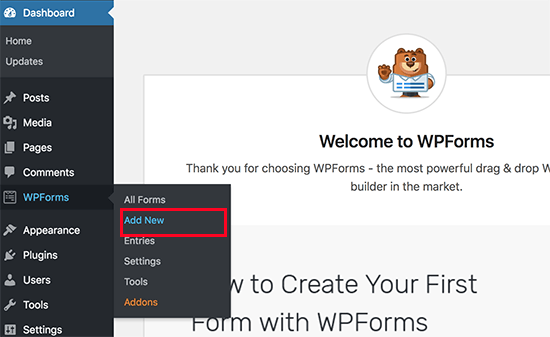
This will open the WPForms builder interface.
First, you need to enter a name for your contact form and then click on the ‘Simple Contact Form’ template.
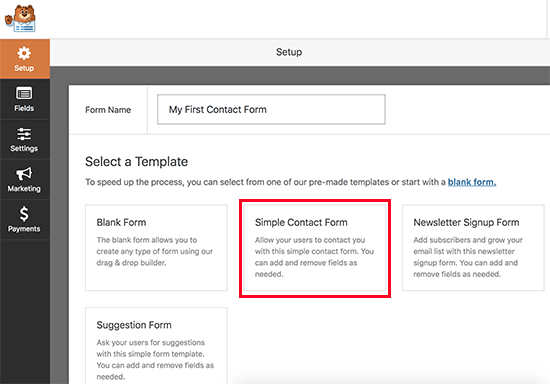
WPForms will now create a simple contact form for you with all the required fields. You can click on any field to change it, or add a new field from the left column.
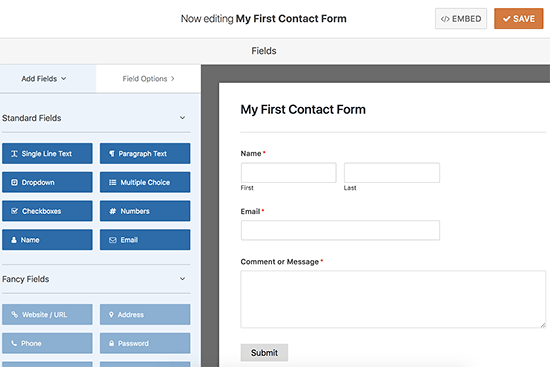
Once you are done editing the form, click on the Save button at the top right corner and then exit the form builder.
You can now create a new page in WordPress by going to Pages » Add New and call it ‘Contact’. On the edit screen, you need to enter the WPForms block into the editor.

After that, select the form you created earlier from the drop-down menu and WPForms will load a live preview of the form in the editor.
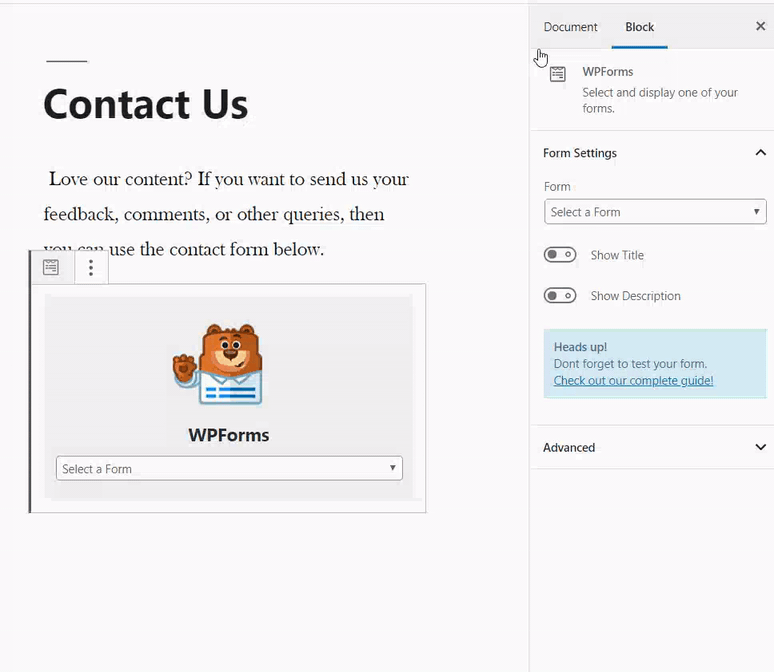
You can now save and publish the page and visit it in your browser to determine your contact form in action.
If you need more detailed instructions, see our step-by-step guide on creating a contact form in WordPress.
As a blogger, the simplest part about WPForms is that it grows with you. Aside from simple contact forms, you’ll also use them to form reader surveys, polls, guest post submission forms, and more.
How to Setup Google Analytics Tracking
Google Analytics helps you see how many people visit your blog, where they are coming from, and what they are doing on your website?
It is best to put in Google Analytics when starting your blog, so you’ll see what proportion your blog has grown over time.
First, you need to visit the Google Analytics website and sign in using your Gmail account.
Once you’re logged in, you’ll plow ahead and check-in for a free Google Analytics account.
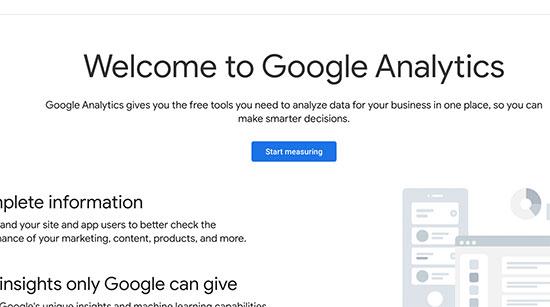
You will be asked to provide your information and website URL. then, you’ll be presented together with your Google Analytics tracking code.
You can stop here because we’ll be employing a plugin to automatically fetch and add this code to your blog (along with fixing proper WordPress tracking).
Switch to your WordPress admin area to place in and activate the MonsterInsights plugin. it’s the free version of the simplest Google Analytics plugin for WordPress, and it’s the simplest thanks to adding Google Analytics to your site (trusted by over 3 million websites).
Upon activation, you would like to go to the Insights » Settings page to configure the plugin settings.
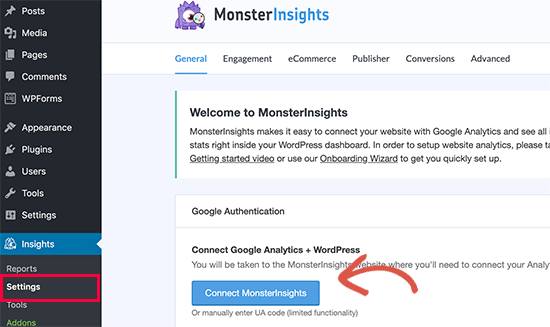
On the settings page, click on the ‘Connect MonsterInsights’ button to attach Google Analytics to your WordPress site.
Follow the on-screen instructions to complete the setup. Once done, you’ll be ready to see your website analytics report straight from your WordPress dashboard under the MonsterInsights tab.
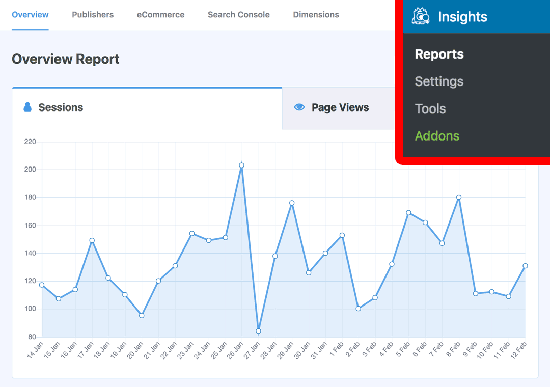
For detailed instructions, see our article on how to install Google Analytics in WordPress.
How to Optimize Your WordPress Blog for SEO
Most beginners don’t optimize for SEO when creating a blog. SEO or program optimization helps users find your blog in search engines. If you’d like more traffic, then it’s crucial that you simply optimize your blog for SEO from the beginning.
To get started, first you would like to put in and activate the beat One SEO plugin. It is the entire WordPress SEO plugin that will assist you to optimize your blog.
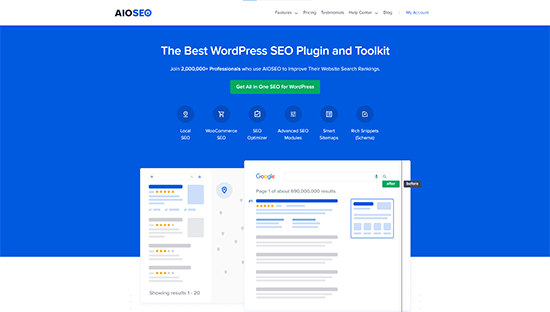
The plugin comes with a quick configuration wizard to help you walk through the setup. It will help you set up a WordPress sitemap, write proper keywords and meta description, add schema markup, and a whole lot more.
We also recommend you follow our complete step-by-step WordPress SEO guide to set up your blog’s SEO.
More WordPress Plugins and Customizations
There are a ton of others WordPress plugins that you can install. Often beginners find it a bit overwhelming to search for the plugins they need.
At Wehavedigitaltool, we often feature the best WordPress plugins to help you add the functionality that you need.
Here is our expert pick of the best WordPress plugins that you should check out.
- Backup – UpdraftPlus is the best WordPress backup plugin. You need to create regular backups of your website in case something ever goes wrong.
- Security – Sucuri Security is a free security scanner for WordPress. We have a complete step-by-step WordPress security guide for beginners that will help you secure your blog.
- Performance – We recommend using either WP Rocket (premium) or WP Super Cache (free) to speed up WordPress. For more on this topic see our article on WordPress speed and performance with step-by-step instructions.
- Design & Customization – We recommend using either SeedProd or Divi page builder to customize your homepage design, create custom landing pages, or even create custom themes (without writing any code). For more on this topic, see our article on the best WordPress page builders (compared).
- Traffic & Subscribers – We strongly recommend using push notifications by PushEngage. This lets you connect with visitors after they leave your website. It’s our top 5 traffic sources on WEhavedigitaltool. For more details, see how to add push notifications in WordPress.
- Email Marketing – We recommend using Constant Contact as your email marketing service. We recommend using OptinMonster free plugin to create high-converting popups, scroll boxes, and call to action to get more email subscribers.
If you are curious about all the plugins and tools we use on our website, check out Wehavedigitaltool’s Blueprint. That list contains all the tools that we use to grow the Wehavedigitaltool blog.
Need more recommendations? See our expert-pick of the must-have WordPress plugins and tools for all websites (hand-picked by our founder, Syed Balkhi).
Step 6. Making Money From Your Blog
Now that you’ve created your blog and customized it to your liking, you are probably wondering how can I actually make money from my blog?
There are a lot of different ways to successfully monetize your blog. However, there is no such thing as a get-rich-quick scheme.
Don’t be fooled by the pictures of expensive cars and mansions because those are all fake.
Unlike other “make money online” articles, we have created the most comprehensive guide on how to make money from your blog using WordPress.
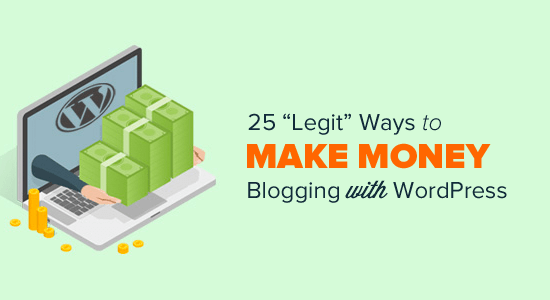
That’s a 4000+ word guide that everyone who wants to make money with their blog needs to read. We have shared our 15+ years of online wisdom in that ultimate guide.
As long as you’re willing to put in the hard work and effort, you’ll reap the reward. Remember, there are no shortcuts.
Here are some of the best ways to make money from your blog.
1. Google AdSense
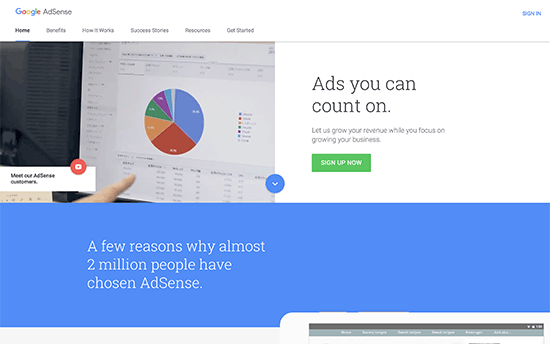
Many bloggers make money by showing ads on their blogs. If you make a blog with monetization in mind, then Google AdSense is the best way to do this.
It is the largest advertising platform for bloggers and publishers. Acting as a middleman between you and the advertiser, Google allows advertisers to bid for keywords matching your content. This allows you to get the best rates possible for the ads.
For more details, see our article on how to properly add Google AdSense to your WordPress blog.
2. Affiliate Marketing

Affiliate marketing is the second most commonly used monetization strategy among bloggers. Basically, you recommend your favorite products/services to your readers, and when they make a purchase you get a referral commission.
The key in affiliate marketing is to recommend high-quality products and services that you already use and trust. There are plenty of affiliate marketing plugins and tools for WordPress that can help you make more money when promoting affiliate products. We recommend using PrettyLinks or ThirstyAffiliates is a must-have.
We also have a complete step-by-step affiliate marketing guide for beginners, that will help you get started.
3. Online Store

Many bloggers make money by selling things directly from their blogs. This could be physical products, digital downloads like ebooks, artwork, music, and more. Some bloggers even offer consulting services.
We recommend using WooCommerce because it is the best eCommerce plugin for WordPress. It is also the most commonly used eCommerce platform in the world.
For detailed instructions, see our guide on how to easily create an online store using WordPress.
Some bloggers don’t want the hassle of creating a store to sell their own products, so they create an Amazon affiliate store that lets them sell other people’s products from Amazon and earn a commission.
On top of the 3 methods above, you can do so much more with your WordPress blog. You can make WordPress blogs specifically for reviews, fashion blogging, food blogging with recipes, and more. Each of these blog types brings you more unique opportunities to make money.
You can also turn your blog into a membership site to offer premium content and courses. We have a detailed guide on how to create and sell online courses with WordPress.
Step 7. Mastering WordPress

Wehavedigitaltool is the largest free WordPress resource site for beginners.
At Wehavedigitaltool, our main goal is to provide cutting-edge helpful WordPress tutorials that are easy to understand for small businesses, bloggers, and non-techy WordPress website owners (see more about us).
To expand your WordPress knowledge, you should check out:
- Dictionary – The best place for beginners to start and familiarize themselves with the WordPress lingo
- Videos – New to WordPress? Watch these 23 videos to master WordPress.
- Blog – The central place for all our WordPress tutorials.
For more discussions, you may want to join our free Facebook group Engage. With more than 73,000 members, the group is focused on helping beginners and non-techy users do more with WordPress.
You can also subscribe to YouTube Channel where we regularly share video tutorials to help you learn WordPress.
Lastly, you can use Google to type your question and add Wehavedigitaltool in front of it. Our users find this trick to be always helpful because it makes it easy for you to find the RIGHT answer for your WordPress questions.
In case you don’t find an answer to your question, don’t worry. Simply use our contact form to send us a message. Our always helpful, full-time Wehavedigitaltool support team, will be happy to assist. We love helping users get started with WordPress.
Frequently Asked Questions (FAQs)
No, that’s not possible. Web hosting is where your website files are stored. All websites need web hosting.
Frequently Asked Questions (FAQs)
Having helped thousands of people start a blog, we have answered quite a lot of questions. Below are the answers to the most frequently asked questions about creating a blog.
Can I create a blog without WordPress?
Yes, there are several other blogging platforms available. We have compared them all, and WordPress is by far the best solution in the market to make a blog with complete ownership and freedom.
Can I build a blog without hosting?
No, that’s not possible. Web hosting is where your website files are stored. All websites need web hosting.
How much does it cost to start a blog?
The cost depends on the add-ons that you buy. We have a complete guide on how much does a WordPress website costs as well as tips on how to save money.
Can I create a blog without my parents knowing about it?
Yes. You can make your WordPress blog private and hide it from the internet. Here is a step-by-step guide on how to make your WordPress blog completely private.
Can I start a WordPress blog and make money with Google Adsense?
Yes, you can use your WordPress blog to earn money from Google AdSense. We have a step-by-step guide on how to add Google AdSense in WordPress.
How can I create a blog and remain anonymous?
If you want to have a public-facing blog but want to remain anonymous, then you need to make sure that your domain has WHOIS privacy turned on. Often people use a pseudonym/nickname to write under. You should also create a unique email just for your blog. It goes without saying, don’t post your pictures or anything on the blog. For more detailed instructions, see our article on how to blog anonymously using WordPress.
How do I add a podcast to my WordPress blog?
WordPress makes it super easy to start a blog and add a podcast to it. We have a step-by-step guide on how to start a podcast with WordPress.
How do I come up with blogging ideas to write about?
Here’s an excellent guide that has 103 blog post ideas that you can write about today. Here’s another guide on 73 types of blog posts that are proven to work.
You can also follow this tutorial from Blogtyrant on how to write a good blog post (12 expert tips) which will help you write great content.
Can I build a blog in my own language?
Yes, you can use WordPress in other languages. You can select your language during installation or from the Settings page in the WordPress admin area. WordPress is fully translated into more than 56 languages and partially translated into dozens of other languages. Many top WordPress themes and plugins are also available in multiple languages. You can also translate a theme or a plugin that you want to use on your website.
How do I create a blog in multiple languages?
Want to start a blog in Hindi, Spanish, or multiple languages? Here’s a step-by-step guide on how to create a multilingual website in WordPress.
Can I design a blog with no coding skills?
Absolutely. You don’t need any programming, coding, or design skills to create a professional-looking WordPress blog.
WordPress themes are easy to customize and you can just point and click to set up your theme. There are WordPress themes like Astra which comes with ready-made starter websites that you can import with one click.
There are other powerful themes like Divi which give you complete drag & drop design options for customizing your blog.
Then there are powerful drag and drop page builders like SeedProd and Divi builder that work with any WordPress theme. You can use it to just drag and drop items and design your own pages.
You can even create your own custom theme without writing any code.
Can I add a photography gallery to my blog?
Yes, WordPress comes with a built-in gallery feature that makes it easy for you to add photo galleries to your blog posts.
Professional photographers can also use premium WordPress gallery plugins to better showcase their photos and even sell photos to make money from their photography business.
How can I create a professional email address for my blog?
If you’re serious about your blog, then we highly recommend that you create a professional business email address (it’s free).
All successful bloggers use professional email addresses to stand out and make better partnership deals to grow their blogs.
We hope that you found our tutorial on how to start a WordPress blog to be helpful. You may also want to check out our article on 27 actionable tips to drive traffic to your new WordPress site, and our checklist on 18 important things to do after installing WordPress.

